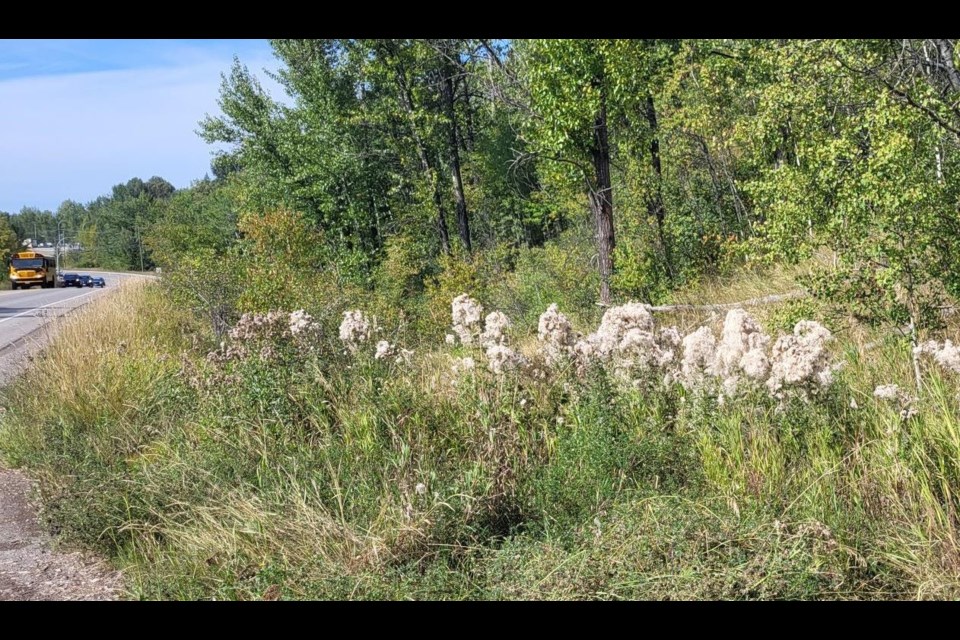It is built to dominate, said a UNBC assistant professor.
It will crowd out native plants, dry up the land and settle into a root network that will boggle the mind.
The Canada thistle is everywhere this year.
Check out both sides of University Hill and North Nechako Road. West of town under the power lines they are rampant, one reader reported, saying it was shameful to see so many.
“If you leave it, it can easily spread about,” said ecosystem science and management assistant Prof. Samuel Bartels of UNBC. “It’s spreading from the rhizomatous roots, which means it has a modified stem that can easily sprout from the roots as well.”
If you see one thistle this year, next year you may see about seven and that quickly becomes a colony, Bartels added.
One flower holds between 1,000 and 1,500 parachute-style seeds that can be carried away on the wind to crowd out native plants essential to the ecosystem.
“And as for the seeds, before you see it, it’s already done its damage,” he said. “The Canada thistle is an invasive species so any opening, any soil disturbance, any clearing of any kind is where it will take hold. It is a wicked plant.”
Canada thistle is designated as a provincial noxious weed by the BC Weed Control Act.
“Even if you take them by the roots, they will still come back in no time,” said Bartels.
“It’s considered a noxious weed because it damages the natural habitat,” he continued. “It affects ecosystems, wildlife, plants, and it does so because the roots excrete a chemical to prevent anything else from establishing around it. This is an allelopathic affect. It’s basically saying don’t come close and it also uses a lot of water. It has a really efficient use of water so it dries out the soil very quickly where it’s found. It will start growing where it’s wet in loamy soils and takes all the moisture to build itself and takes much of the nutrients so if it’s in the crops it’s really depriving them of much needed nutrients.”
When thistles first start to grow they establish the root system first. Then their leaves spread laterally and low to the ground to block out the sun, offering a hostile environment for other plants, he added.
“Nothing can really establish near it,” Bartels said. “It is built to dominate any native species.”
Is there a solution?
“Any effort towards eradication really helps in the sense that the plant puts much effort into establishing the root system so if you cut it off, pull it out, it has to be before the flowers come out and it goes to seed,” Bartels said. “So if you see it and it’s not flowering yet and you pull it up you have done something to the plant and it will take some time for it to use its resources for shoot development. So anything helps.”
If you have them on your lawn mow them as soon as you see them and if you can kill it that’s even better, he added.
“Some people use vinegar, so if you cut it you can pour vinegar into the stem and desiccate the roots and in that case you can keep applying and keep applying to try to kill the root,” Bartels suggested.
There are targeted herbicides that are very specific to individual species and then there are broad spectrum that kills everything, he added.
“The City of Prince George recognizes the abundance of Canada thistle this year and continues to address invasive species on city land through strategic management,” the city's parks department said in a statement.
“Our premier parks (Rainbow, Connaught Hill and Lheidli T’enneh) are prioritized for treatment, and we also tackle other areas as needed, guided by service levels. The city also uses specialized mowers to mechanically manage thistle in accessible areas. In places like ditches, manual removal is necessary and can be challenging due to time and budget constraints.”
In Edmonton in 2017 there was a project that saw a goat herd of about 170 animals take on the challenge of managing the thistles and other noxious weeds at Rundle Park, Bartels said.
“I witnessed goats in action and they were specifically trained to chew thistles and you could see them browsing through the area,” he smiled. “It was quite the sight.”
For a larger area in a public space the city could consider using goats to chew the thistles, Bartels suggested, still smiling.
“While the idea of using goats is interesting, the pilot hasn't been proven effective enough in a municipal setting as of yet,” the parks department replied in response to the suggestion. “Instead, we work closely with the Northwest Invasive Plant Council, with an annual partnership of nearly $20,000. We provide them with a list of areas, and they assist in managing noxious weeds in those locations. We also work with community groups like the Prince George Naturalists Club, who assist us in controlling invasive species in specific areas such as the Hudson Bay Wetland and Carrie Jane Gray Park. While full eradication isn't feasible, we strive to manage invasive species to the best of our ability.”
For residents managing thistles on private property, the parks department recommends securely bagging the plants and taking them to the landfill. Thistle should not be composted, as the seeds can survive in compost and can spread when used in gardens.


.png;w=120;h=80;mode=crop)
